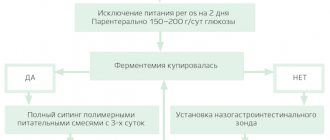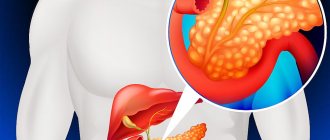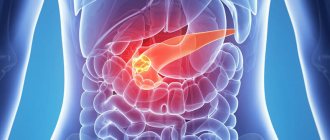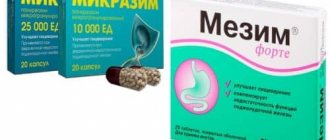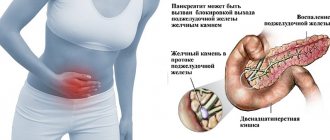A gastroenterologist treats diseases of the pancreas in Nizhny Novgorod.
The pancreas plays a huge role in the human body.
The pancreas is responsible for metabolic and digestive processes in the body.
The pancreas is the most important secretory organ of the human body.
Today, the most popular diseases of the pancreas are treated in Nizhny Novgorod - pancreatitis, pancreatic necrosis, cancer, cysts and diabetes.
What are the functions of the pancreas?
The pancreas performs two important functions.
- It produces enzymes (digestive enzymes) and releases them into the duodenum. Enzymes in the digestive tract break down carbohydrates, proteins and fats. This is the so-called exocrine function.
- Another function is endocrine , which is performed by beta cells of the islets of Langerhans, producing insulin (hormone), and alpha cells, producing glucagon. Insulin controls the level of glucose (sugar) in the blood. It acts against hyperglycemia (high blood sugar) and glucagon corrects hypoglycemia (low blood sugar). Insulin also promotes the absorption of glucose in the liver, where it is stored in the form of glycogen, and then used during stress and exercise. When the islets of Langerhans produce little insulin, glucose levels rise and there is a risk of developing diabetes, etc.
The role of the pancreas in our body
13.10.2021
What is the pancreas and what is its purpose in the human body? Most people are familiar with the name of this organ, but they may not be familiar with what this gradular organ does. Essentially, the pancreas plays an important role in the human digestive system by producing enzymes that help break down food in the intestines .
What does the pancreas look like?
Below the ventricle, underneath the abdominal cavity, is the pancreas , which is 6 to 10 inches long and extends horizontally across the abdominal cavity. Its shape is often compared to a fish because it has a large head and a small tail and is divided into four parts:
- Head : It is located on the right side of the abdomen , where the abdomen meets the duodenum, the first part of the small intestine.
- Neck : This is the thin section between the head and the body of the pancreas .
- Body: middle part of the pancreas .
- Tail : This small tip is located on the left side of the abdomen and sits very close to the spleen.
The pancreas is actually made up of two types of glands, identified by their tissue names, exocrine and endocrine tissues, but works together as a single unit. Exocrine tissue contains 95 percent of the pancreas and is responsible for producing enzymes that aid in digestion. The remaining 5 percent consists of endocrine cells called "islets of Langerhans", which have the important function of releasing hormones that control the amount of pancreatic enzymes produced and also to control blood sugar levels .
Pancreatic enzymes that aid digestion
Below are three types of pancreatic enzymes that are responsible for digesting food:
- Lipase works with bile to break down fat in food so it can be used by the body. diarrhea and fatty stools may occur The human body cannot get the healthy fat it needs.
- Protease helps break down proteins in food and keeps the intestines free of bacteria and yeast. If a person does not have enough protease, there may be a higher risk of developing intestinal infections.
- Amylase helps convert carbohydrates into food into sugar. A deficiency of this enzyme can lead to diarrhea due to undigested starch in the colon.
The pancreas works hard to produce these three types of enzymes and can generate up to eight cups of these enzymes daily. However, if you are not careful with your diet , the pancreas can be damaged and, ultimately, this will lead to a disease such as pancreatitis .
Pancreatitis
Basically, pancreatitis is a condition in which the pancreas becomes swollen or inflamed, causing abdominal , vomiting, and nausea . One common risk factor for pancreatitis is alcoholism. In fact, excessive alcohol consumption accounts for 75% of cases of chronic pancreatitis .
Gallstones, hard substances usually formed from excess cholesterol in the gallbladder , are another common cause of pancreatitis . When the gallbladder empties on its own, gallstones will travel along the pancreatic and cause a blockage, leading to pancreatitis .
Treatment
Treatment for pancreatitis usually begins with fasting to help the pancreas rest from producing enzymes. After this, the endoscope can be used to perform various tasks, such as placing a stent on the pancreas or removing gallstones. Surgery may be required, especially if there is an abscess and rotten tissue. Once you begin to recover from treatment, a healthy lifestyle should be adopted to help the condition become chronic.
Published in Gastroentorology Premium Clinic
Common diseases of the pancreas
Pancreatitis
Acute pancreatitis is an inflammation of the pancreas that occurs rapidly. The disease occurs when the release of the enzymes it synthesizes from the gland is difficult and “self-digestion” of the organ occurs, causing acute pain.
The most common causes of acute pancreatitis are infections, alcohol abuse, and gallstones that enter the bile duct (the pancreas is connected to the bile duct at the point where it enters the duodenum) and block the release of enzymes. Other factors include certain medications, damage to the gland (physical), mumps, and pancreatic cancer.
Chronic pancreatitis is a sluggish, periodically recurring exacerbation of inflammation of the pancreas. During exacerbation, symptoms of acute pancreatitis appear, and in the remission phase, mainly digestive disorders. When treating pancreatitis, it is necessary to treat diseases that could cause chronic inflammation. It is important to stop drinking alcohol. If there are stones in your gallbladder, our doctor will refer you to have them removed. The doctor prescribes drugs that reduce the secretion of gastric juice, as well as enzyme agents that do not contain bile components. It is recommended to fast for the first few days of treatment. It is allowed to drink non-carbonated alkaline mineral waters and weak tea.
Benign neoplasms
Cysts are located directly in the pancreas or in surrounding tissues. They often cause pain and compression of the ducts and must be removed. Benign tumors (fibromas, lipomas, adenomas, etc.) also appear in the gland, which are also removed surgically.
Pancreas cancer
Cancer usually affects the cells of the main duct of the gland and spreads to the body of the organ.
Risk factors include smoking, chronic pancreatitis and age over 65 years. Advanced pancreatic cancer can spread to the abdominal organs and lead to death.
For treatment, surgical methods, chemotherapy, radiation therapy and lifelong administration of insulin, etc. are used.
Chronic pancreatitis.
Chronic pancreatitis is diagnosed when the disease develops as a result of a protracted inflammatory process occurring in the pancreas. Men over 40 are most susceptible to the disease.
Symptoms and causes of chronic pancreatitis in Nizhny Novgorod.
The most common causes of chronic pancreatitis are the presence of cholelithiasis in the patient and excessive consumption of alcoholic beverages.
Eating fatty, low-quality foods, carbonated drinks, and alcohol also contributes to the development of chronic pancreatitis.
The presence of chronic pancreatitis is indicated by cutting pain. Also, belching, vomiting, bloating, problems with bowel movements, lack of appetite, weight loss are symptoms of chronic pancreatitis.
Methods for diagnosing chronic pancreatitis at Only Clinic.
If chronic pancreatitis is suspected, a gastroenterologist at the Only Clinic prescribes the following set of examinations to the patient:
General blood test: with chronic pancreatitis, there is an increase in the concentration of leukocytes in the blood, an increase in the erythrocyte sedimentation rate, and an increase in amylase levels.
- General urinalysis: shows an increase in amylase.
- Ultrasound of the abdominal cavity and pancreas.
- CT, MRI to identify foci of disease and the presence of stones.
Prevention of pancreatic diseases
It should be remembered that the functioning of the gland is most negatively affected by alcohol, smoking, irregular meals, fried, spicy and fatty foods. All this should be avoided. The diet should be healthy. You need to eat four to five times a day, and moderation in food is also important.
Pancreatic diseases should be taken seriously and be thoroughly examined in order to receive optimal treatment.
Our clinic offers modern diagnostic methods with consultation of experienced specialists for the treatment of pancreatic diseases. Don’t delay until later and make an appointment with a gastroenterologist right now.
Symptoms
The following symptoms are the harbingers of the pathological process:
- decreased performance;
- drowsiness;
- weakness;
- fainting;
- convulsions;
- causeless weight gain.
Hypertrophied pancreatic function tends to become chronic, since at the initial stage the pathology is difficult to determine due to mild clinical symptoms. As the disease progresses, the following symptoms appear:
Causes of sudden nausea
- After waking up, a person has difficulty concentrating and orienting in space. Patients find it difficult to answer simple questions; they may repeat the same movements over and over again;
- excited state;
- seizures with symptoms reminiscent of epileptic seizures;
- arrhythmia;
- impaired consciousness;
- retrograde amnesia, in which a person does not remember how he ended up in a particular place;
- absent-mindedness;
- constant feeling of hunger;
- tremor (shaking) of the limbs;
- paralysis of facial muscles;
- decreased memory and thinking abilities;
- impaired taste sensitivity and swallowing function;
- facial hyperemia (redness);
- hyperhidrosis - sweating;
- instability of blood pressure.
The pathological process leads to impaired memory and mental abilities
Diagnosis of the disease
To correctly diagnose a patient, it is necessary to analyze his medical history, complaints, and make the following diagnostics:
- the amount of glucose measured before meals should be in the range from 0 to 3 mmol/l;
- the amount of insulin measured should be less than 72 pmol/l;
- abstaining from eating by the patient for 12-16 hours, as a result, an attack of hypoglycemia, then we give glucose - the attack subsides;
- computer research of the body.
When diagnosing this disease, an important factor is identifying and eliminating the causes of increased secretion, otherwise recovery will not be successful.
ethnoscience
In fact, traditional medicine is quite successful in solving the problem of this disease. However, each person has the right to independently choose methods and methods of treatment, and traditional medicine comes to his aid. Below are some folk recipes that help in the treatment of pancreatic hyperfunction:
- drink an infusion of dill seeds (1 teaspoon per 200 ml of boiling water) during the day;
- oatmeal without oil and salt can be served up to several times a day;
- a mixture of lemon, parsley and garlic in a ratio of 1/0.3/0.3, grated through a meat grinder (take a teaspoon 3 times a day before meals);
- infusion of kefir and buckwheat (half a liter of kefir per 150 g of buckwheat for 12 hours), consume in two doses - morning and evening;
- in case of an acute attack, an infusion of herbs is indispensable - calendula, chamomile, mint, plantain, corn silk (preparation of solution: mix herbs, pour 1 tablespoon of the mixture into 1 liter of boiling water and bring to a water bath, consume before meals diluted with warm water in a ratio of 1 mixture/4 water);
- for chronic disease, honey mixed with dry dandelion, thyme, nettle root, hop cones will help (grind the herbs, mix, mix 5 tablespoons with a glass of honey, take a spoon twice a day, morning and evening).
This is not a complete list of folk remedies, but any of the listed methods will significantly improve a person’s condition within the first week, relieve bloating, colic, discomfort and body pain.
However, you don’t need to limit yourself only to diets and folk recipes. It is necessary to include physical education and breathing exercises, long walks in the fresh air in the complex of activities.
Treatment of hyperfunction
Treatment of hyperfunction of the pancreas comes down to the introduction of glucose into the human body. When insulinoma appears in the body, surgery and removal are required. In this case, therapy is prescribed to reduce the production of insulin in the body.
But the most important factor in successful treatment of the gland is:
- proper dietary nutrition (more carbohydrates, vegetables and fruits);
- drinking plenty of water;
- rejection of bad habits;
- physical training.
Type 1 diabetes mellitus as an extreme case of pancreatic hypofunction
Acute pancreatic hypofunction is nothing more than type 1 diabetes mellitus, which is an autoimmune disease. Type 1 diabetes mellitus can be induced by a viral infection, as well as various environmental stress factors against the background of a hereditary predisposition. This type of diabetes is characterized by a seasonal incidence with an increase in late autumn and winter (the peak incidence occurs in October and January).
In type 1 diabetes mellitus, the weight and size of the pancreas is smaller than in individuals without diabetes mellitus or in patients with type 2 diabetes mellitus. The number of islets, as well as the amount of insulin extracted from the pancreas, is significantly less in patients with type 1 diabetes mellitus compared to the norm.
In the etiopathogenesis of type 1 diabetes mellitus, it is advisable to highlight a genetic predisposition that is associated with certain antigens of the HLA leukocyte antigens system (Human Leucocyte Antigens), which is connected to immune response genes. Antigens of the HLA system are located on a small section of the sixth autosomal chromosome, where 5 loci have been identified: A, B, C, D, DR. Antigens of loci A, B, C are found in all nuclear cells of the body, antigens of locus D (DR, DRW) are found in B lymphocytes and macrophages. It has been established that a genetic predisposition to type 1 diabetes mellitus is associated with the HLA antigens B8 and B15 (the likelihood of developing the disease is 2.5-3 times higher than in persons who do not have these antigens, and with the simultaneous presence of B8 and B15, the risk of the disease increases in 8-9 times).
Note 1
In patients with type 2 diabetes, the distribution of antigens does not differ from that in the general population. A study of locus D showed that the presence of type 1 diabetes mellitus is combined predominantly with the presence of antigens DW3, DRW3, DR4 and DRW4, while the DRW2 antigen is a marker of a relatively small risk of type 1 diabetes mellitus (causes protective and protective effects).
